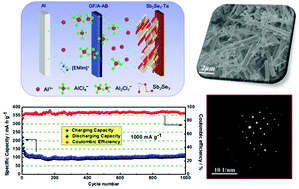Sb2Se3 nanorods with N-doped reduced graphene oxide hybrids as high-capacity positive electrode materials for rechargeable aluminum batteries†
Abstract
For substantially promoting the unexpected rechargeable capability induced from the dissolution of Sb2Se3 positive electrode materials in aluminum batteries, here a novel prototype of a cell assembled by a hybrid of single-crystalline Sb2Se3 nanorods and N-doped reduced graphene oxide (SNG) coupled with a modified separator has been developed. With this specific cell design, the hybrid positive electrode material exhibits a high discharge potential (∼1.8 V) with a considerably high initial discharge capacity of up to 343 mA h g−1 at a current density of 500 mA g−1. Owing to the alleviation of active material loss from the positive electrode, the cell having the modified separator exhibits much enhanced cycling stability. Besides, nitrogen-doping on the reduced graphene oxide is found to boost the active sites in SNG, and thus the cycling performance has been largely improved. The strategy used in this work offers a universal plateau for designing long-life cycle aluminum batteries.



 Please wait while we load your content...
Please wait while we load your content...